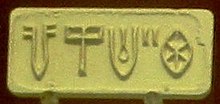
Back Indusskrif Afrikaans الكتابة السندية Arabic Escritura del Indo AST Indus Schrift BAR সিন্ধু লিপি Bengali/Bangla Escriptura de l'Indus Catalan Harappské písmo Czech Indusschrift German Escritura del Indo Spanish خط ایندوس Persian
| Indus script | |
|---|---|
 Seal impression showing a typical inscription of five characters | |
| Script type | Undeciphered;
possibly Bronze Age writing or proto-writing |
Time period | c. 3500–1900 BCE[1][2][a] |
| Direction | Right-to-left script, boustrophedon |
| Languages | Unknown (see Harappan language) |
| ISO 15924 | |
| ISO 15924 | Inds (610), Indus (Harappan) |
The Indus script, also known as the Harappan script and the Indus Valley Script, is a corpus of symbols produced by the Indus Valley Civilisation. Most inscriptions containing these symbols are extremely short, making it difficult to judge whether or not they constituted a writing system used to record a Harappan language, any of which are yet to be identified.[3] Despite many attempts,[4] the "script" has not yet been deciphered, but efforts are ongoing. There is no known bilingual inscription to help decipher the script,[5] which shows no significant changes over time. However, some of the syntax (if that is what it may be termed) varies depending upon location.[3]
The first publication of a seal with Harappan symbols dates to 1875,[6] in a drawing by Alexander Cunningham.[7] By 1992, an estimated 4,000 inscribed objects had been discovered,[8] some as far afield as Mesopotamia due to existing Indus–Mesopotamia relations, with over 400 distinct signs represented across known inscriptions.[9][5]
Some scholars, such as G. R. Hunter,[10] S. R. Rao, John Newberry,[11] and Krishna Rao[12] have argued that the Brahmi script has some connection with the Indus system. Raymond Allchin[13] has somewhat cautiously supported the possibility of the Brahmi script being influenced by the Indus script.[14][15] Another possibility for the continuity of the Indus tradition is in the megalithic graffiti symbols of southern and central India and Sri Lanka, which probably do not constitute a linguistic script but may have some overlap with the Indus symbol inventory.[16][17] Linguists such as Iravatham Mahadevan, Kamil Zvelebil, and Asko Parpola have argued that the script had a relation to a Dravidian language.[18][19]
- ^ Kenoyer (2006), pp. 10–11.
- ^ Bryant (2001), p. 178.
- ^ a b Locklear, Mallory (25 January 2017). "Science: Machine learning could finally crack the 4,000-year-old Indus script". The Verge. Manhattan, New York, NY: Vox Media. Retrieved 25 January 2017.
After a century of failing to crack an ancient script, linguists turn to machines.
- ^ Possehl (1996).
- ^ a b Robinson (2015).
- ^ Wright (2009), p. 7.
- ^ Cunningham (1875), pp. 105–108.
- ^ Fairservis (1992), p. 5.
- ^ Ghosh (1990).
- ^ Hunter (1934).
- ^ Newberry (1980), pp. 10–20.
- ^ Ghosh (1990), p. 361–364.
- ^ Allchin & Erdosy (1995), p. 336.
- ^ Goody (1987), pp. 301–302, note 4.
- ^ Salomon (1995).
- ^ Mahadevan (2004).
- ^ Ray (2006), pp. 121–122.
- ^ Rahman, Tariq. "Peoples and languages in pre-Islamic Indus valley". Archived from the original on 9 May 2008. Retrieved 20 November 2008.
most scholars have taken the 'Dravidian hypothesis' seriously
- ^ "The Indus Script | Harappa". www.harappa.com. Retrieved 22 May 2020.
Cite error: There are <ref group=lower-alpha> tags or {{efn}} templates on this page, but the references will not show without a {{reflist|group=lower-alpha}} template or {{notelist}} template (see the help page).
© MMXXIII Rich X Search. We shall prevail. All rights reserved. Rich X Search